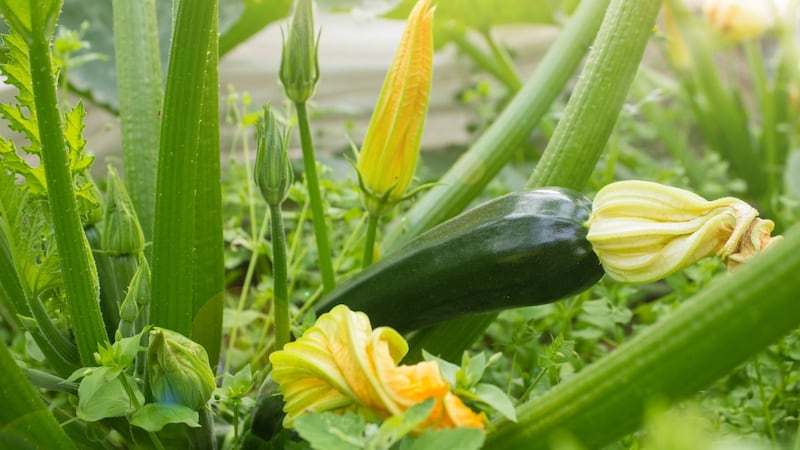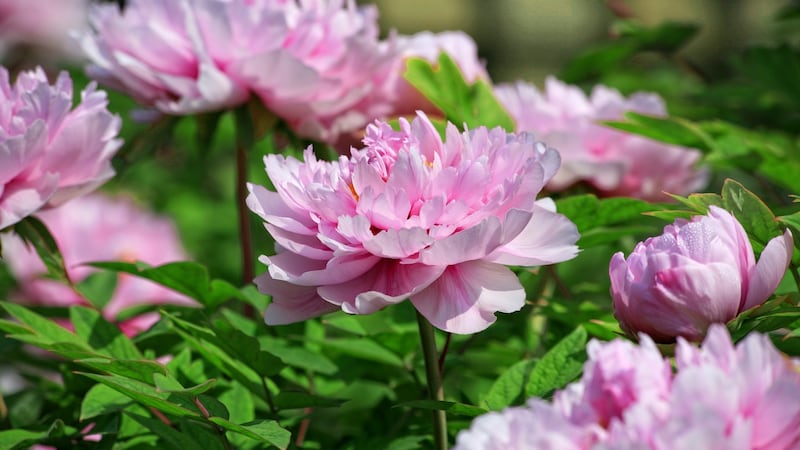Wondering what to do in the garden this week? Here are some ideas to inspire you.
Grow some joy
There’s something irrepressibly joyful about sunflowers with their giant saucer-shaped, pollinator-friendly blooms and their jaunty, reach for the stars habit of growth. Now is a good time to sow seed of these half-hardy, fast-growing annuals, either directly outdoors or into small individual pots on a bright windowsill indoors/under cover of a sunny porch, glasshouse, polytunnel or conservatory for planting outside in the coming weeks as young transplants.
Many different varieties are available to buy as seed, from the lofty Helianthus ‘Kong’ which can reach a height of more than 3m to the multiflowered Helianthus ‘Soraya’ (height of 1.8m, dark-orange flowers) and the chocolate-maroon coloured Helianthus ‘Moulin Rouge’ (height of 120cm-180cm). Young container-grown plants are also often available from good garden centres at this time of year.
Sunflowers need a rich, moisture-retentive but free-draining soil and a sheltered, sunny spot while some form of support is also recommended. Seed suppliers include all good Irish garden centres, as well as seedaholic.com and tuinzaden.eu
Go forth and propagate
At this time of year, many kinds of plants can be easily, quickly and cheaply propagated from “softwood cuttings”, a wonderful way to almost instantly increase stock of many of your favourite plants. Softwood cuttings are typically 5-10cm sections of stems cut from the parent plant (early morning is best) just below a leaf joint/node and then gently stripped of their lower leaves before being quickly “planted” into a 1-2 litre pot filled with good-quality seed-and-cuttings compost lightened with a handful of coarse horticultural grit or vermiculite.
Watered generously and then covered with an upturned clear 3 litre plastic freezer bag sealed with an elastic, the labelled pot should then be placed somewhere warm but out of direct sunshine (a heated propagator is ideal) and watered occasionally to keep the compost slightly damp.
Depending on the species, softwood cuttings typically develop viable root systems within 4-6 weeks, at which point they can be gently potted-on and then gradually hardened off. Species suitable for propagating this way include dahlia, salvia, hydrangea, lavender, fuchsia, buddleia, philadelphus, clematis, pelargonium, chrysanthemum, ribes, perovskia, osteospermum, betula, magnolia, dianthus and penstemon.

Grow some food
Now that the threat of damaging late frosts has almost certainly passed, half-hardy vegetables such as courgettes, sweet corn, Florence fennel, pumpkins and squash can be planted outdoors into their final growing positions in the garden or allotment. Just make sure to harden off the young plants before doing so by gradually acclimatising them to the cooler, more variable growing conditions with which they’ll have to contend.
All of these fast-growing vegetables are heat-lovers that need a sunny, sheltered spot and a fertile, weed-free soil to do well. If your garden or allotment is a windy or exposed one, then try to create temporary shelter by erecting sections of windbreak netting around plants and growing them through some form of plant support such as chicken wire or horizontal netting kept in place with wooden stakes.
Plan ahead
It may seem strange to already be planning for next year, but early summer is the perfect time to sow seed of many different kinds of flowering biennials from foxgloves (Digitalis purpurea) and sweet William (Dianthus barbatus) to wallflowers (Erysimum cheiri), honesty (Lunaria annua) and sweet Rocket (Hesperis matronalis), all of which will flower next spring/ summer from seed sown at this time of year.
Sow the seed into covered pots under cover of a bright porch, conservatory, glasshouse, polytunnel or cold frame, or outdoors into a well-prepared seed bed where the soil has been raked to a fine, crumbly tilth, making sure to take precautions against slugs and snails that might damage emerging seedlings. Once the seedlings are large enough to handle, they can then be either pricked out into cell trays/individual modules or grown on in the ground for transplanting into their final position in autumn.
If your preference is the latter, just make sure to thin out the seedlings enough to give their root systems sufficient space to properly develop (carefully handled, these thinnings can also be pricked out to give more plants if required).
Keep them coming
Fast-growing summer-flowering annual climbing plants, such as sweet pea (Lathyrus annua), morning glory (Ipomaea), the cup-and-saucer vine (Cobaea scandens), black-eyed Susan (Thunbergia alata) and the purple bell vine (Rhodochiton atrosanguineus), can quickly get messily out of hand unless their new growth is regularly trained against some form of sturdy vertical support in the shape of netting, chicken wire or sections of horizontal wire firmly secured to posts, fencing, pergolas, arches, trellising or a wall.
All of these colourful, short-lived climbers need to be kept well-watered and regularly deadheaded and benefit hugely from a fortnightly liquid seaweed foliar feed (available from all good garden centres as well as online suppliers such as seamegrow.com and fruithillfarm.com) which helps to support healthy growth and the plentiful production of their pretty flowers. Liquid foliar feeds can be given using a watering can with a fine rose attachment or using a hand-held pressure sprayer (mrmiddleton.com).

Perfect peonies
A classic element of traditional cottage-garden style borders and the perfect planting partner for other cottage garden favourites such as roses, lupins, catmint and perennial geraniums, herbaceous peonies are one of the loveliest flowers of the early summer garden with their heavy, blowsy blooms in romantic shades of plum, pink, white and coral. Hardy and exceptionally long-lived, peonies (or peony roses as they’re sometimes known) like a rich, moisture-retentive but free-draining soil enriched with plenty of well-rotted organic matter and a sheltered spot in full sun. Particularly garden-worthy varieties include the white, double-flowered, scented Peony ‘Duchesse de Nemours’ (flowers June-July); the blood-red Peony ‘Buckeye Belle’ (flowers May-June) and the flouncy, blush-pink, double-flowering ‘Sarah Bernhardt’ (June-July). Now is a great time to buy the plants in bloom so you can be certain of getting your preferred variety.
To encourage healthy vigorous plants, avoid planting deeply, deadhead any faded flowers, cut dead growth back to ground level in late autumn and mulch lightly around (but not on top of) plants in spring. Peonies are available from all good Irish garden centres as well as specialist Irish nurseries including Wicklow-based Leamore Nursery (leamorenursery.com).
Beautiful bedding
Get the most out of expensive bedding plants by briefly pre-soaking their root balls in tepid water (add a little liquid seaweed feed if you have it) before planting them into fresh, good-quality, multipurpose compost enriched with some slow-release organic pelleted fertiliser. Before planting, always check for signs that any plants have become root-bound, always a risk with these kinds of very fast-growing species. Dense, very firm, fibrous root systems that completely fill the pot should be gently torn at the base to encourage roots to stretch outwards and downwards while it’s also a good idea to gently nip out any weak leggy growth. The same goes for any faded flower stems (keep deadheading these throughout the summer) and for any damaged or broken leaves. Also take careful precautions against slugs and snails, which love to munch on soft, succulent growth.
Bear in mind that most kinds of summer bedding need full sun to do well, while none will cope with full shade. Species that will deal well with light shade include busy lizzies (Impatiens walleriana), begonias, nicotiana, violas and fuchsia.
Tend those tomato plants
Greedy, heat-loving and demanding, tomato plants need consistent care and attention through the summer months if they’re to flourish and become properly productive. This is especially true of what are known as “indeterminate” or vine varieties, which can quickly become a sprawling tangle of stems without regular intervention.
To keep them healthy, happy and in good shape, regularly nip out any side shoots (these can be used as softwood cuttings to grow more plants if required, see above) and keep training the main stem vertically using a bamboo stick or some strong twine suspended from the roof of your glasshouse/polytunnel. Water the soil/compost around plants when it starts to look dry but avoid overwatering or wetting the leaves as this increases the risk of disease. Once the first flower truss has set fruit (you’ll see what looks like tiny little tomatoes), start giving your plants a weekly liquid tomato feed.
For a detailed, expert online guide to growing delicious tomatoes, check out the blog of the Dublin-based organic gardener Nicky Kyle, nickykylegardening.com













